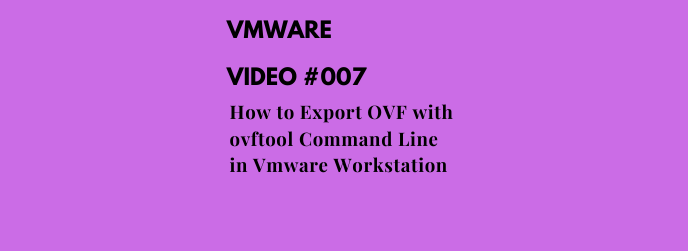This article describes How to Export OVF with ovftool Command Line in Vmware Workstation
A virtual machine is a software computer that, like a physical computer, runs an operating system and applications. The virtual machine is comprised of a set of specification and configuration files and is backed by the physical resources of a host. Every virtual machine has virtual devices that provide the same functionality as physical hardware and have additional benefits in terms of portability, manageability, and security.
A virtual machine consists of several types of files that you store on a supported storage device. The key files that make up a virtual machine are the configuration file, virtual disk file, NVRAM setting file, and the log file. You configure virtual machine settings through the vSphere Web Client or the vSphere Client. You do not need to touch the key files.
A virtual machine can have more files if one or more snapshots exist or if you add Raw Device Mappings (RDMs).
A virtual machine (VM) is a software program or operating system that not only exhibits the behavior of a separate computer, but is also capable of performing tasks such as running applications and programs like a separate computer. A virtual machine, usually known as a guest is created within another computing environment referred as a "host." Multiple virtual machines can exist within a single host at one time.
A virtual machine is also known as a guest.
A virtual machine is a computer file, typically called an image, that behaves like an actual computer. In other words, a computer is created within a computer. It runs in a window, much like any other program, giving the end user the same experience on a virtual machine as they would have on the host operating system itself. The virtual machine is sandboxed from the rest of the system, meaning that the software inside a virtual machine can’t escape or tamper with the computer itself. This produces an ideal environment for testing other operating systems including beta releases, accessing virus-infected data, creating operating system backups and running software or applications on operating systems they weren’t originally intended for.
Virtualization is the process of creating a software-based, or virtual, representation of something, such as virtual applications, servers, storage and networks. It is the single most effective way to reduce IT expenses while boosting efficiency and agility for all size businesses.
VMware is a virtualization and cloud computing software provider based in Palo Alto, California. Founded in 1998, VMware is a subsidiary of Dell Technologies. EMC Corporation originally acquired VMware in 2004; EMC was later acquired by Dell Technologies in 2016. VMware bases its virtualization technologies on its bare-metal hypervisor ESX/ESXi in x86 architecture.
With VMware server virtualization, a hypervisor is installed on the physical server to allow for multiple virtual machines (VMs) to run on the same physical server. Each VM can run its own operating system (OS), which means multiple OSes can run on one physical server. All of the VMs on the same physical server share resources, such as networking and RAM.
Diane Greene, Scott Devine, Mendel Rosenblum, Edward Wang and Edouard Bugnion founded VMware, which launched its first product -- VMware Workstation -- in 1999. The company released its second product, VMware ESX in 2001.
VMware Workstation is a virtual machine software that is used for x86 and x86-64 computers to run multiple operating systems over a single physical host computer. Each virtual machine can run a single instance of any operating system (Microsoft, Linux, etc.) simultaneously. VMware Workstation strongly supports hardware compatibility and works as a bridge between the host and virtual machine for all kinds of hardware resources including hard disks, USB devices and CD-ROMs. All device drivers are installed via the host machine.
VMware ESX is an enterprise-level product developed by VMware Inc. that is used for server virtualization. It runs without requiring an existing operating system on the physical machine. VMware ESX is embedded hypervisor software and is available in two versions: ESX Server and ESXi Server.
Open Virtualization Format (OVF) is an open-source standard for packaging and distributing software applications for virtual machines (VM).
An OVF package contains multiple files in a single directory. The directory always contains an Extensible Markup Language (XML) file called the OVF descriptor with the name, hardware requirements, and references to other files in the package. In addition, the OVF package typically contains a network description, a list of virtual hardware, virtual drives, certificate files, information about the operating system (OS) and in some cases, a human-readable description of every information item.
The OVF standard is one of several standards and initiatives supported by the Distributed Management Task Force (DMTF). VMware, a company that provides virtualization software for x86 computers, offers a widely-used OVF package. Numerous other vendors including IBM, Microsoft, JumpBox, VirtualBox, XenServer, AbiCloud, OpenNode Cloud, SUSE Studio, Morfeo Claudia, and OpenStack use OVF in their virtualization products.
You can import an Open Virtualization Format (OVF) virtual machine and run it in Workstation Pro. Workstation Pro converts the virtual machine from OVF format to VMware runtime (.vmx) format. You can import both .ovf and .ova files.
OVF is a platform-independent, efficient, extensible, and open packaging and distribution format for virtual machines. For example, you can import OVF virtual machines exported from VMware Fusion™ or Oracle VM VirtualBox into Workstation Pro. You can import OVF 1.0 and later files only.
You can also use the standalone OVF Tool to convert an OVF virtual machine to VMware runtime format. The standalone version of the OVF Tool is installed in the Workstation Pro installation directory under OVFTool. See the OVF Tool User Guide on the VMware Web site for information on using the OVF Tool.
Now you can find some examples in this video.
Please subscribe to support our channel.
To be aware of our new videos please subscribe our channel.
Visit our website https://sdk-it.com
Visit our youtube channel
Watch IT & Learn IT & Apply IT.
Enjoy!






